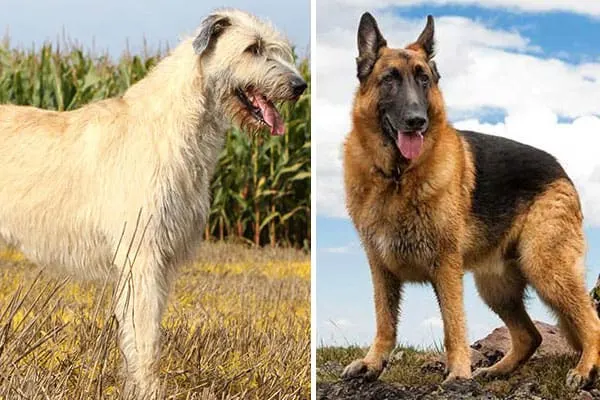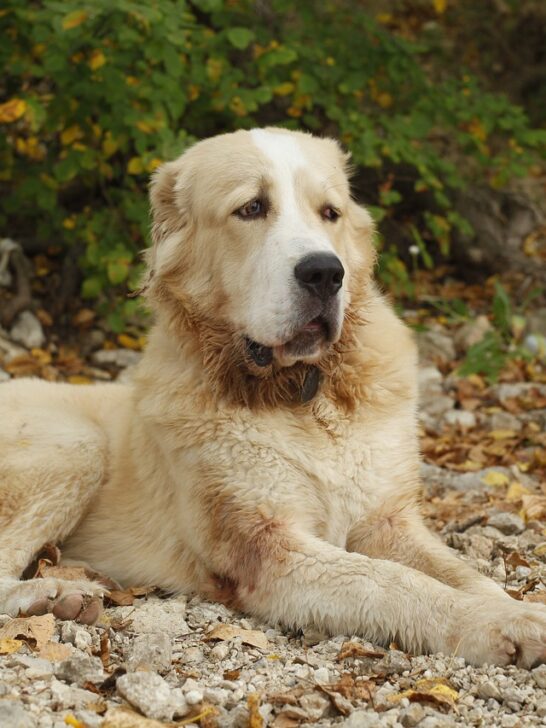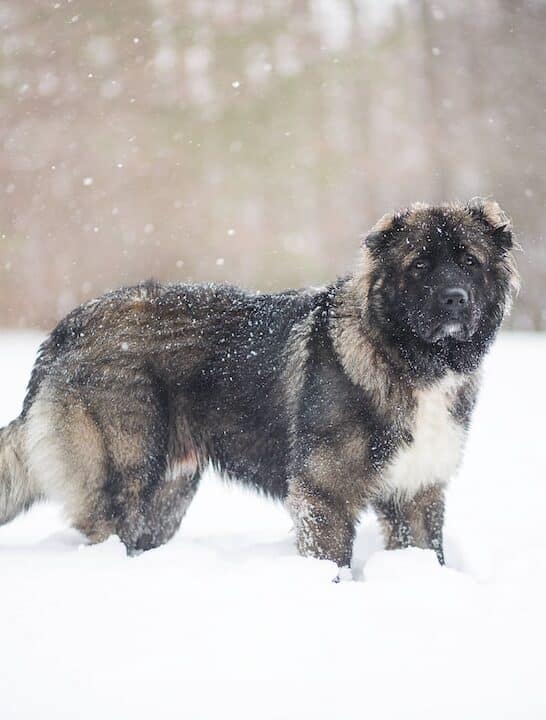What Do You Need to Know About the Irish Wolfhound German Shepherd Mix?
If someone asked you to name the tallest dog breed, what would you say? You know it is not a German Shepherd, but is it a Mastiff or Saint Bernard?
You may have even thought Great Dane, and a Dane named Zeus does indeed hold the world record for the tallest dog. However, the tallest breed on average is the Irish Wolfhound.
People are always interested in different mixes of dog breeds. So, what happens when you blend the world’s tallest dog with one of the most sought-after breeds, the German Shepherd?
Do you get the fastest police dog or maybe the hardest-working sighthound?
An Irish Wolfhound German Shepherd mix is a large dog with a variable appearance. She is generally friendly with perhaps a slight protective instinct.
She does best as a watchdog, is good with children, potentially aggressive with other animals, and better with cold weather than warm climates.
Irish Wolfhound Shepherds are fast, agile, loyal, and self-assured, usually with a heavy fur coat.

The origins of the parent breeds are quite different
The contrasts between the German Shepherd and Irish Wolfhound begin fittingly enough with origins. Irish Wolfhounds are one of the oldest breeds of dogs and German Shepherds among the most recent.
Present as early as 273 B.C., the Irish Wolfhound was a war dog that the Romans, Greeks, and Irish all used. Wolfhounds had particular prowess for dismounting cavalry because of their size and strength.
Roman gladiators used Irish Dogs as ferocious combatants in their sporting arenas.
When conflicts resolved in Ireland, the Irish used their huge sighthounds for hunting boars, elk, wolves, and bears.
Eventually, Irish Wolfhounds guarded livestock against predators, especially wolves, similarly to the Anatolian Sheepdog.
Irish Wolfdogs soon became a sign of nobility, often accompanying King and Queens and guarding their castles.
The number of Wolfhounds someone owned was a status symbol, and a gift of an Irish Dog was a great honor.
As the Shepherd was taking root in the 1850s, the Irish Wolfhound had almost become extinct along with its namesake, the Irish Wolf.
Captain George Augustus Graham began a breeding program to restore the Irish Wolfhound to its original form in 1863.
Outcrossings with Great Danes had begun in the 1700s, but the resulting offspring were clumsier than the nimble Wolfhounds.
Graham may have added Borzoi and Scottish Deerhound, bringing speed, agility, and additional coat colors to the modern Irish Wolfhound.
The German Shepherd Dog officially burst onto the purebred scene in 1899. German Shepherd types had been in the process of separating from the French, Belgian, and Dutch Shepherds for decades.
The magic began when Max von Stephanitz found a show dog with all of the physical attributes of an ideal working dog and proclaimed him the first GSD.
Von Stephanitz was to further refine the breed by outcrossing with different types of herding dogs across the German region.
He then inbred the resulting offspring back with the original German Shepherd, Hektor, and a couple of this founding dog’s sons.
German Shepherds quickly found use as police and military use, although their roles in wars were different than the Wolfhound.
The GSD was mostly a messenger and ambulance assistant and now engages in ground combat and bomb detection.
What about the appearance of your crossbred dog?
There is such a vast gap between the appearances of the two-parent breeds that you will not find many Irish Wolfhound Shepherd mixes that look the same.
Moreover, it is not a very common mix. The only thing you know for certain is your puppy will have brown eyes and become a large dog.
Most Wolfhound Shepherd mixes are black and tan, sable, gray, fawn, or black. A few may be brindle.
More than likely, you will deal with four distinct types.
The first, fairly rare, is a beautiful long-haired animal that looks like a refined German Shepherd variation with upright ears, a GSD refined head, and a heavier and shorter height and longer frame than the Wolfhound with a sable wooly coat.
A more common type is the indeterminate group that features individuals that look like giant terrier mixes.
They have a blend of characters of both parents, resulting in semi-prick or drop ears, a coarse face between that of the Shepherd and Wolfhound, a medium build with noticeably long legs, and the black and tan pattern of a GSD with a lot of blue or gray.
The dogs usually have medium-long fur that looks scruffy around the face.
The other two types include one that looks like a German Shepherd with short fur and a boxier face and one that looks like an Irish Wolfhound with refinement in the muzzle, smoother coat, and a golden or brown impression.
Irish Wolfhound German Shepherd mixes have a significant size
A German Shepherd male is 24 to 26 inches high at the shoulders and weighs about 65 to 85 pounds.
The minimum height for an Irish Wolfhound should be 32 inches at the shoulder with a weight of 120 pounds or more.
The average Irish Dog is 32 to 35 inches tall and weighs 140 or more pounds.
Females of both breeds are approximately two inches shorter and about 10 to 20% lighter.
Is the Irish Wolfhound German Shepherd mix good for guarding?
Irish Wolfhounds, although generally gentle now, were historically fierce protectors of both livestock and property.
Modern Wolfhounds are not as aggressive as they were in ancient Rome and have lost much of their suspicion and reservation with strangers.
German Shepherds are traditional guard dogs, both territorial and protective of their families. However, the original intention of the GSD guard dog was to warn of danger and attack as a last resort.
They should be reserved and watchful but polite, if a little aloof, around friendly guests.
German Shepherds should not react aggressively against strangers when on an outing with their owners, such as on a jog.
Your Irish Wolfhound Shepherd mix may be watchful and reserved with strangers.
She will probably be friendlier than a Shepherd with guests but more aggressive against intruders than a Wolfhound and more watchful when you are not home.
Her size alone will more often than not be sufficient to ward off anyone intending mischief. If her presence is not enough to deter intruders, she has a formidable bark.
Your Irish Wolfhound GSD hybrid will not be ideal for apartment living
Not only are Wolfhound Shepherd mixes large to giant-sized, but they are also active enough that an apartment or condo would be too confined for them.
Moreover, with the emergence of numerous policies against large-breed and guard type dogs on rental properties, your Shepherd mix may be prohibited from certain dwellings.
What is training and intelligence like in the Wolfhound cross?
Stanley Coren’s work to try to find an objective way to rate canine intelligence has received much recognition.
He classified how intelligent breeds are based on memory, obedience, problem analysis, reaction to social situations, and the environment.
Some criticize the rankings as weighted too heavily in favor of obedient dogs.
Nevertheless, it is a great attempt to objectify a dog’s cleverness. In some cases, you can attribute a breed’s low ranking to independent thinking and lack of a cooperative spirit.
Keep in mind that it simply ranks dogs against each other, and canids as a group is highly intelligent.
After all that, German Shepherds are No. 3 on Coren’s list and No. 1 or 2 on other lists, always grouped in the exceptional category with Border Collies, Poodles, and Dobermans.
Irish Wolfhounds are No. 41 in company with Australian Shepherds, Curly-Coated Retrievers, and Fox Terriers. Coren’s standard considers Wolfhounds average in inherited and environmental canine smarts.
Although a few hybrids inherit surprisingly little intelligence from their parent breeds, your Irish Wolfhound GSD mix should be smart, eager to please, and relatively easy to train.
He will be a large dog, so consistent, firm, and early training is crucial.
Dominance traits may emerge from the German Shepherd side and a need for multiple repetitions of lessons from the Wolfhound.
Like most canines, your dog will respond best to positive reinforcement and may fight back against harsh training methods.
How should your dog do in your family setting?
German Shepherds are typically aloof with strangers and often must be well-socialized to behave politely.
There are plenty of Shepherds, especially from show and pet lines, who are moderately friendly once they get to know someone.
Exercise caution, however, because some GSD families produce timid and fear-biting dogs.
Irish Wolfhounds, according to Petful.com, are friendly dogs who lost their guarding instinct a long time ago.
Your Irish Wolfhound mix will probably be reserved with strangers at the first meeting only to quickly warm.
Some hybrids will be outgoing while those who inherit more of their personality from the Shepherd might be standoffish.
Other Pets
You probably will not be able to trust your Wolfhound Shepherd mix with small animals. Both the Irish Wolfhound and GSD have strong prey drives.
Although the Wolfhound no longer hunts, she retains a tendency to chase moving living things. Moreover, Wolfhounds are exceptionally fast with formidable jaw power, able to run down any dog they pursue.
Both Wolfhounds and Shepherds can be aggressive to other dogs, whether socialized or not. Same-sex aggression is common in the GSD and a bit more infrequent in the Wolfhound.
Socialize your Irish Wolfhound Shepherd mix early so he can get along with other animals.
Avoid situations that may trigger his prey drives, such as a dog park with small running Poodles and Dachshunds.
Also, exercise caution leaving him unattended with a cat or other small pet, no matter how well they seem to get along. If things go south, your little furry companions will not stand a chance.
Assess your dog’s personality as an ongoing task so you can spot whether she is dog-aggressive or imagines herself the most proficient of hunters.
Children
German Shepherds often must learn how to act with children. They play better with teens and children over ten years of age, but can easily look at infants and toddlers as needing protection.
Irish Wolfhounds love children according to and other sources, but their humungous size can make them a hazard to toddlers learning to walk.
Your Wolfhound GSD hybrid will likely enjoy the company of children. You need to monitor her around smaller children because of her size and power. Some hybrids are remarkably gentle.
Once she passes the puppy stage of 18 to 24 months, your dog will likely not be excessively boisterous.
Is there liability to owning an Irish Wolfhound mix?
Any time you own a large breed in the current social environment, you can run into liability issues.
If your dog involves himself in an incident, everyone will scrutinize him more closely if he belongs to certain canine groups, i.e., bulldog-terriers, or because of his size.
However, we did not see Irish Wolfhounds on any dangerous dog lists in the United States. Ukraine bans them, but it has over 80 dog breeds on its list.
You will likely have trouble getting a Wolfhound into a rental building because of her size and intimidation factor.
Many insurance policies and lease owners classify German Shepherds as guard dogs and ban them outright along with Dobermans.
However, a concerning trend sees an increasing number of countries and municipalities imposing bans on owning a GSD, one of the most popular dogs worldwide.
Ironically, for our story, Ireland is a country that bans German Shepherds.
You should check with your homeowner’s association or other pertinent organizations before you acquire a new dog, especially one the size of an Irish Wolfhound mix.
A few policies expand their bans and restrictions to mixes even with 10% of the prohibited breed.
You may have a mix with no recognizable Shepherd present to the casual observer, but chances are someone will be able to tell your dog is part GSD.
If you are searching for a new home and puppy together, check your regulations, so you ensure your dog has somewhere to live.
If you are persistent, you can find people who still judge dogs based on personality and not breed.
Measures you can take to improve the personality of your Irish Wolfhound Shepherd mix are ongoing socialization, buying from a reputable dog breeder who appears to care about animal welfare, and meeting one or both parents where possible.
Socializing your puppy does not end when she reaches adulthood. Eastern German and Czech working GSD lines may not be mentally mature until they are three years old.
Giant breeds, albeit not as sensitive as German Shepherds, still take two years to fully mature.
While the crucial cutoff for the most effective socialization for dogs ends around 16 weeks old, it would not hurt for you to expose your Irish Wolfhound Shepherd mix to a variety of stimuli, animals, and people well into her third year.
Building social skills is a form of training and conditioning.
It is important to eliminate sources of fear and anxiety that come from a sheltered existence, and that can lead to inappropriate aggression. You can even lessen the effects of genetics with persistent socialization.
Is the Irish Greyhound Shepherd a healthy mix?
Will my Wolfhound mix live a long time?
According to Petmed.com, Irish Wolfhounds only live six to ten years. German Shepherds live 10 to 12 or 13 years. Your mix will probably live closer to the 11 to 13-year range depending on how big he gets.
There are a few health concerns
The Irish Wolfhound Shepherd hybrid can inherit certain problems from his parent breeds.
- Von Willebrands disease (both breeds) – a clotting disorder that causes excessive bleeding.
- Hip Dysplasia (GSD) – As with most sighthounds, Irish Wolfhounds have a low incidence of hip dysplasia for a large breed. Wolfhounds have under a 5% occurrence compared with around 20% for German Shepherds, according to the OFA. However, 14% of Wolfhounds tested had elbow dysplasia in 2019, and about 18% of Shepherds. Your mix may inherit hip or elbow dysplasia.
- Bloat – Large deep-chested dogs are more vulnerable than other breeds to the stomach distending, allowing it to twist.
- Progressive retinal atrophy (both breeds) – The Irish Shepherd and GSD both had an incidence of general eye abnormalities of around 2%. You can have your veterinarian test your dog’s eyes at a young age.
- Megaesophagus (both breeds) – A devastating disorder where the esophagus has poor muscle tone, a large esophagus can lead to food inhalation and corresponding pneumonia. Affected dogs often need their food elevated which leaves them more prone to bloat.
Always figure semi-annual veterinary check-ups, customized vaccination schedules, various consults, radiographs, and other tests into the cost of owning an Irish Wolfhound Shepherd mix.
What will your dog’s grooming requirements be?
The Irish Wolfhound requires considerable attention to his coat. He has a dense, soft undercoat with a hard or wiry overcoat that is longer in certain areas.
Wolfhound owners typically trim the beard, eyebrows, and between the toes, especially if showing.
Other owners engage in stripping their Irish Wolfhounds, pulling out dead and unsightly overcoat hairs to facilitate new fur growth.
Your hybrid’s grooming needs will depend on which coat type he inherits. If he is lucky to get a short GSD coat, he may shed a lot but will need only weekly brushing.
Other coat variants will require you to brush more frequently. The Irish Wolfhound standard coat is prone to the mat, unlike the GSD.
Your mix will do well in winter, but you will need to monitor her in the heat.
The Irish Wolfhound, unlike Salukis and some other sighthounds, does not do exceptionally well in hot weather, according to Dogtime.com.
Monitor your hybrid as her adjustments to summer will depend on her coat type. The German Shepherd’s coat better insulates in summer than the Wolfhounds.
How much exercise does your Irish Wolfhound-Shepherd need?
According to Dog-learn.com, adult Wolfhounds require 45 minutes to an hour of exercise daily. German Shepherds, built and developed for stamina, need an hour and a half to two hours of activity every day.
Plan on engaging your Irish Wolfhound-Shepherd in rigorous exercise for 30 to 45 minutes and training or other mental activity for another 15 to 30 minutes a day.
You may have to gauge your dog’s requirements based on energy.
Some mixes may have the exercise needs of a working GSD. Your mix can probably engage in the same activities as a Shepherd, like agility, fly ball, and Shutzhund.
A few individuals may enjoy lure coursing, while others can excel at herding. You can also try to search and rescue and track.
What does the Irish Wolfhound GSD mix look like, again?
The following videos are two examples of the mix. This first film illustrates a dog that looks most like a GSD. Note the shaggy fur and how the quality of hair is much like an Irish Wolfhound.
You can make out Irish Wolfhound in this dog’s face and expression. This is a very athletic and speedy dog.
This video illustrates a puppy who looks much like an Irish Wolfhound with a more refined face, unusual dark pigment patterning for a Wolfhound, and shorter fur. Note the relatively long legs.
Compare the puppy with the purebred Shepherd, possibly his mother.
Related Reading: The German Shepherd Greyhound Mix: Forever Loyal and Like a Flash




















